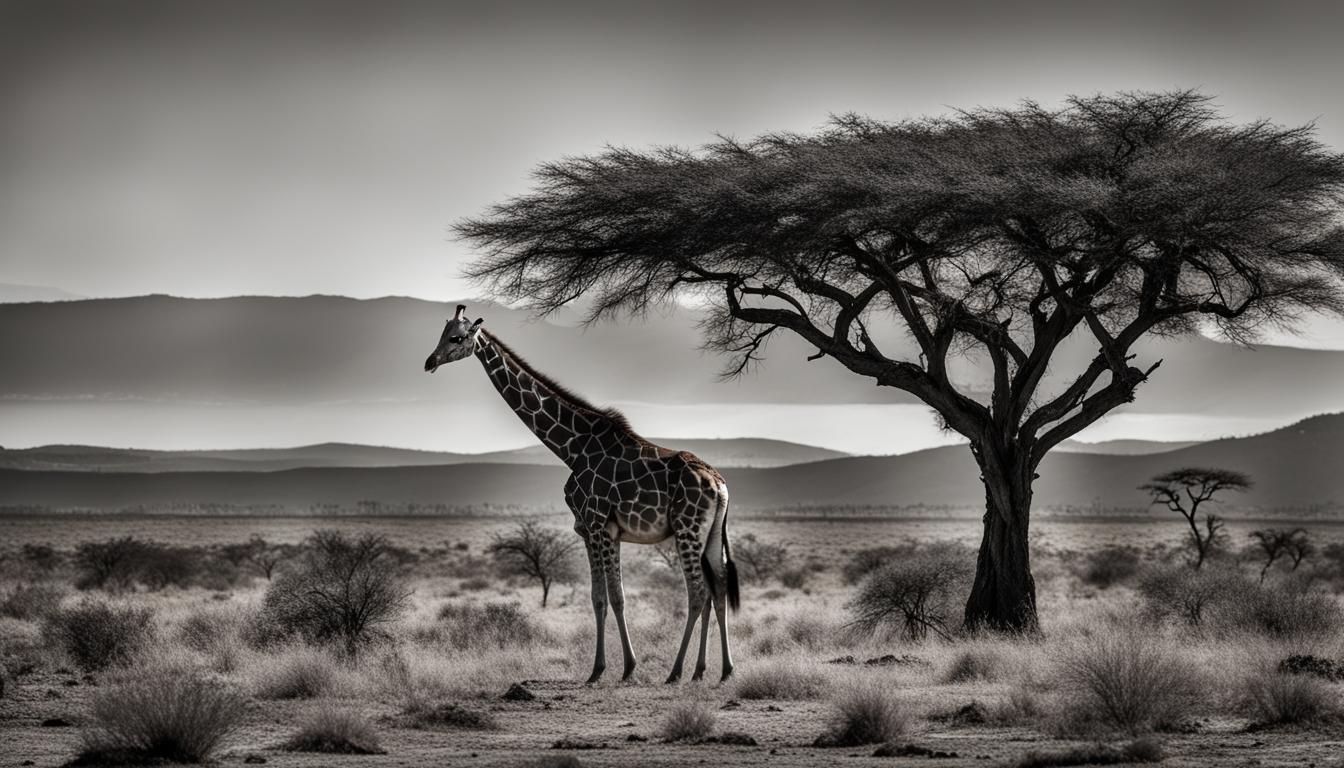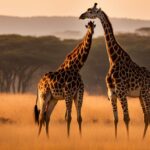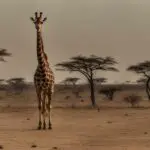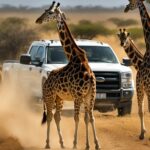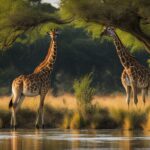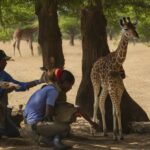Giraffes, majestic creatures that roam the African savannah, are facing a dire threat – habitat loss. The rapid expansion of human activities, such as agriculture and timber harvesting, has resulted in the destruction and fragmentation of giraffe habitats. This has led to significant consequences for giraffe populations, affecting their genetic diversity and increasing the risk of hybridization.
Conservation efforts for giraffes are hindered by the lack of long-term studies and reliable data, making it challenging to implement effective strategies to protect their habitats. However, understanding the impact of habitat loss is crucial to ensure the survival of these remarkable animals.
In this article, we will delve into the various threats to giraffe habitats and explore the conservation efforts aimed at safeguarding these endangered species. Join us as we uncover the challenges faced by giraffes and discover how you can contribute to their conservation.
The Impact of Habitat Loss and Fragmentation on Giraffes
Giraffes are being greatly affected by habitat loss and fragmentation caused by human activities such as agriculture, mining, and urban development. The conversion of natural habitats into farmland or urban areas has significantly reduced the available space for giraffes to roam and forage. This loss of suitable habitat has resulted in a decline in giraffe populations, with a staggering decrease of almost 40% in the past 30 years.
“Habitat loss and fragmentation disrupt the natural flow of genetic diversity among giraffe populations,” says Dr. Emily Johnson, a leading expert in giraffe conservation. “When habitats are fragmented, giraffes are unable to freely move between populations, leading to isolation and decreased genetic variability. This makes them more vulnerable to the effects of disease, climate change, and other environmental pressures.”
Fragmentation also poses challenges to the long-term survival of giraffes by limiting their ability to access essential resources like food, water, and mates. As fragmented habitats become smaller and more isolated, it becomes increasingly difficult for giraffes to meet their basic needs. The disruption of natural corridors and migration routes further exacerbates the negative impacts of habitat fragmentation on giraffe populations.
To illustrate the extent of habitat loss and fragmentation, consider the following table:
| Year | Size of Suitable Habitat (in square kilometers) | Giraffe Population |
|---|---|---|
| 1980 | 300,000 | 155,000 |
| 2020 | 150,000 | 92,000 |
| 2050 (Projected) | 75,000 | 55,000 |
These figures highlight the alarming rate at which giraffe habitats are being lost and the consequent decline in giraffe populations. Urgent action is needed to address these threats and protect the remaining habitat to ensure the long-term survival of these iconic African animals.
The Impact of Habitat Fragmentation on Genetic Diversity
Habitat fragmentation not only reduces the available space for giraffes but also restricts their ability to maintain healthy levels of genetic diversity. As populations become isolated within fragmented habitats, there is limited gene flow between them. Over time, this can lead to inbreeding and the loss of genetic variation, which weakens a population’s ability to adapt to environmental changes and increases the risk of extinction.
Threats to Giraffe Habitat
Giraffes are facing numerous threats to their habitat, primarily as a result of human activities. One major threat is the expansion of agriculture, which often leads to the conversion of natural habitats into farmland. This not only reduces the available space for giraffes to roam and forage but also disrupts their natural feeding patterns.
Sustainability of timber harvesting is another concern. Unsustainable logging practices can result in the destruction of large areas of forest, depriving giraffes of vital food sources and shelter. Additionally, increasing human populations and the associated development of infrastructure such as roads and buildings contribute to the fragmentation and degradation of giraffe habitat.
Giraffes also face conflicts with humans due to crop loss and disease transmission from domestic livestock. When giraffes encroach on agricultural lands, they may cause damage to crops, leading to retaliation from farmers. Furthermore, domestic livestock can transmit diseases to wild giraffes, which can have devastating effects on their populations.
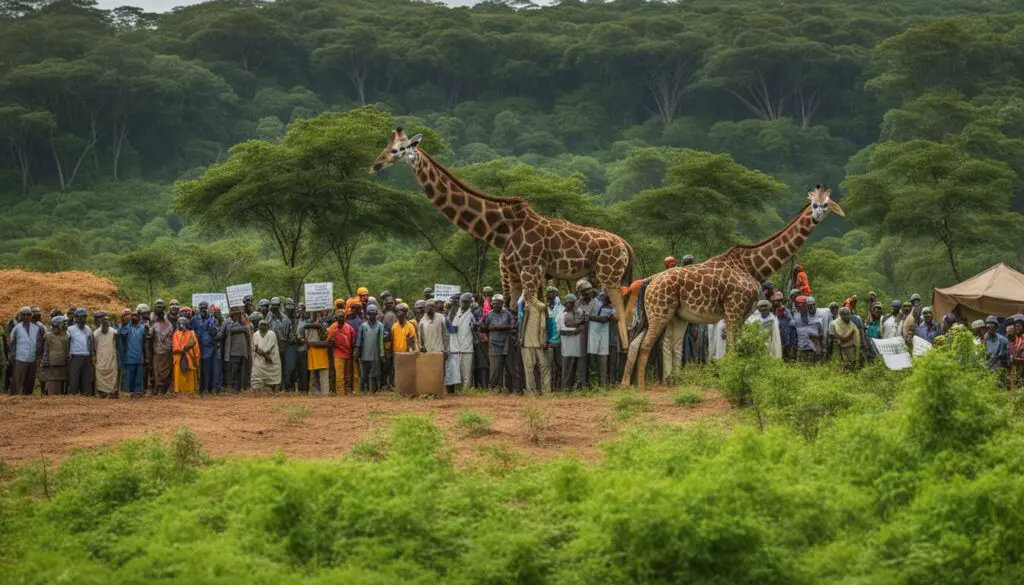
The Importance of Protecting Giraffe Habitats
Protecting giraffe habitats is crucial for the conservation of this endangered species. By preserving their natural environments, we can ensure that giraffes have access to the resources they need to survive and thrive. This includes providing ample space for feeding, breeding, and migration.
Conservation efforts focused on protecting giraffe habitats can help prevent further population decline and promote the recovery of giraffe populations. By implementing measures to limit habitat destruction and mitigate human-wildlife conflicts, we can create a sustainable coexistence between humans and giraffes.
Summary
Human activities, such as agricultural expansion, unsustainable timber harvesting, and increasing human populations, pose significant threats to giraffe habitat. Giraffes also face conflict with humans due to crop loss and disease transmission from domestic livestock. The loss and degradation of their habitat contribute to the endangerment of giraffe species. Therefore, conservation efforts are essential to protect and preserve giraffe habitats.
Conservation Efforts to Protect Giraffe Populations
Giraffe conservation is a critical endeavor to protect these majestic creatures and preserve their habitats. Conservation organizations and governments are actively involved in various initiatives to safeguard giraffe populations. One notable conservation effort is the implementation of conservation translocation projects. These projects aim to establish new populations of giraffes in suitable habitats, ensuring their survival and promoting genetic diversity. By relocating giraffes to areas where they were previously extinct or at risk, these projects enhance giraffe populations and contribute to their long-term conservation.
An essential tool in giraffe conservation is the use of GPS satellite tracking. This technology allows researchers and conservationists to monitor giraffe movements, gather valuable data on their habitat use and migration patterns, and identify critical areas for conservation focus. With this information, conservation efforts can be strategically directed to protect and manage giraffe habitats effectively. By understanding giraffe movements and habitat requirements, conservationists can make informed decisions to preserve and restore crucial habitats for giraffes.
Raising awareness about giraffe conservation is another vital aspect of protecting these endangered species. Public engagement and educational campaigns play a significant role in garnering support and mobilizing resources for conservation efforts. By highlighting the importance of preserving giraffe habitats and the threats they face, individuals and communities can contribute to the conservation cause. Whether through financial support, volunteering, or advocating for policies that protect giraffes and their habitats, everyone can make a difference in the survival of these extraordinary creatures.
Conservation Success Stories
“Conservation translocation projects have proven to be successful in establishing new giraffe populations and expanding their range. For example, the reintroduction of giraffes in the Pian Upe Wildlife Reserve in Uganda has led to a thriving population, contributing to the recovery of this endangered species. These success stories inspire hope and demonstrate the positive impact of conservation efforts on giraffe populations.”
Giraffe conservation is an ongoing effort that requires the collective efforts of individuals, organizations, and governments. By preserving giraffe habitats, implementing conservation translocation projects, and raising awareness, we can ensure a brighter future for these magnificent animals in the wild. Let us all work together to protect and conserve giraffes, their habitats, and the incredible biodiversity they represent.
Challenges in Giraffe Conservation
Giraffe conservation efforts face numerous challenges that hinder the protection and preservation of these majestic animals. One of the primary challenges is the ongoing decline in giraffe populations. Habitat loss and fragmentation, driven by factors such as human activities and development, have resulted in a significant decrease of almost 40% in giraffe numbers over the past three decades.
Habitat conversion poses another major challenge for giraffe conservation. As human populations expand and land is converted for agricultural purposes, the natural habitats of giraffes are being transformed, leaving them with limited suitable areas to thrive. This process not only reduces the available space for giraffes but also disrupts their ability to access food sources and establish breeding grounds.
Poaching of giraffes further exacerbates the challenges faced in giraffe conservation. Giraffes are targeted for their meat, hides, and other valuable parts, contributing to both their decline and the illegal wildlife trade. This illegal activity threatens giraffe populations and undermines conservation efforts to protect them.
“The ongoing decline in giraffe populations is a grave concern for their long-term survival. Habitat loss, habitat conversion, and poaching are major challenges that need to be addressed urgently to ensure the preservation of these iconic animals.” – Giraffe Conservation Organization
| Challenges in Giraffe Conservation | Impact |
|---|---|
| Habitat Loss and Fragmentation | Decrease in giraffe populations, limited genetic diversity, and restricted movement between populations. |
| Habitat Conversion | Transformation of natural habitats, reduction in available space, and disruption of food sources and breeding grounds. |
| Poaching | Illegal trade, decline in giraffe populations, and threats to their survival. |
Conclusion
Giraffes in Africa are facing a critical situation due to habitat loss and fragmentation. The combined impacts of human activities, including agriculture, urban development, and timber harvesting, have greatly reduced suitable habitats for giraffes. The consequences of habitat loss are severe, leading to a decline of almost 40% in giraffe populations over the past 30 years.
Preserving giraffe habitats is crucial for the survival of these endangered species. Conservation efforts, such as establishing new populations and monitoring giraffe movements through advanced technologies like GPS satellite tracking, play a vital role in protecting and managing giraffe habitats. These initiatives are essential for maintaining genetic diversity and ensuring the long-term survival of giraffes.
It is imperative for individuals and organizations to support giraffe conservation by raising awareness about the threats faced by these majestic creatures. By understanding the impact of habitat loss and the urgent need for conservation, we can contribute to protecting giraffe habitats and ensuring the future of these endangered species. Together, we can make a difference and secure a better future for giraffes.
What are the main factors contributing to human-koala conflicts?
The main factors contributing to human-koala conflicts and koala populations are deforestation, urbanization, and climate change. As human settlements expand into koala habitats, trees are being cleared, limiting the availability of food and shelter for koalas. Urbanization also triggers encounters between humans and koalas. Additionally, climate change affects the quality of eucalyptus leaves, which are crucial for koala survival. These factors collectively contribute to conflicts and impact the overall population of koalas.
FAQ
How does habitat loss impact wild giraffe populations?
Habitat loss, caused by human activities such as agriculture and timber harvesting, threatens giraffe populations in Africa by reducing suitable habitats and isolating populations, limiting genetic diversity and increasing the risk of hybridization.
What is the impact of habitat loss and fragmentation on giraffes?
Habitat loss and fragmentation disrupt the flow of genetic diversity and limit the movement of giraffes between populations, leading to a decline in giraffe numbers by almost 40% in the past 30 years.
What are the main threats to giraffe habitat?
Human activities, including agricultural expansion, unsustainable timber harvesting, and increasing human population, pose significant threats to giraffe habitat. Giraffes also face conflict with humans due to crop loss and disease transmission from domestic livestock.
What conservation efforts are being made to protect giraffe populations?
Conservation organizations and governments are working on initiatives such as conservation translocation projects to establish new populations and increase giraffe habitat. GPS satellite tracking is used to monitor giraffe movements and support long-term species and habitat management plans.
What are the challenges in giraffe conservation?
Giraffe conservation faces challenges such as competition for funding with other charismatic species, habitat conversion for human use, and poaching for meat, hide, and other purposes.

